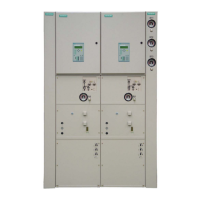=USNJVOTPKV=G=fkpq^iiqflk=fkpqor`qflkp=Ua^=G=oÉîáëáçå=MP 35
fåëí~ää~íáçå
! Repeat the above work operations for all other panel connections in the same panel.
Replacing desiccant bags
in the circuit-breaker hous-
ings
The desiccant bags are located behind the cover of the rupture diaphragm at the side of
the circuit-breaker housing. The cover has the inscription "Filter".
! Remove the lateral cover of the rupture diaphragm with the "Filter" inscription on
one circuit-breaker housing.
! Unpack two new desiccant bags of 250 g each per pole, and put them completely
into the holder.
! Prepare the housing flange for assembly (see Section "Preparing the flanges of the
busbar housings", Page 24).
! Clean the contact surfaces of the cover of the rupture diaphragm with a lint-free
paper, and apply a thin film of grease.
! Put the cover of the rupture diaphragm with the bags into position, observing that no
part of the bags is jammed in the contact surfaces in order to prevent leaks.
! Bolt the covers tight crosswise. Tightening torque: 20 Nm.
! Repeat the above work operations for all circuit-breaker housings on the same panel
where the desiccant bags must also be fitted.
! After completing the replacement of desiccant agent in the panel, evacuate the
circuit-breaker housings and fill them with SF
6
-gas (see below).
Fig. 25: Cover of rupture diaphragm on circuit-breaker
housing
a
Cover of rupture diaphragm
ATTENTION!
In the ambient air, the desiccant bags lose their effectiveness rapidly and cannot be
used anymore.
! Use only desiccant bags whose packing is not damaged and whose humidity
indicators in the packing are blue.
! Do not use desiccant bags if the humidity indicators are pink.
! After opening the packings, mount the desiccant bags in the gas compartment
within 30 minutes and close the gas compartment hermetically.

